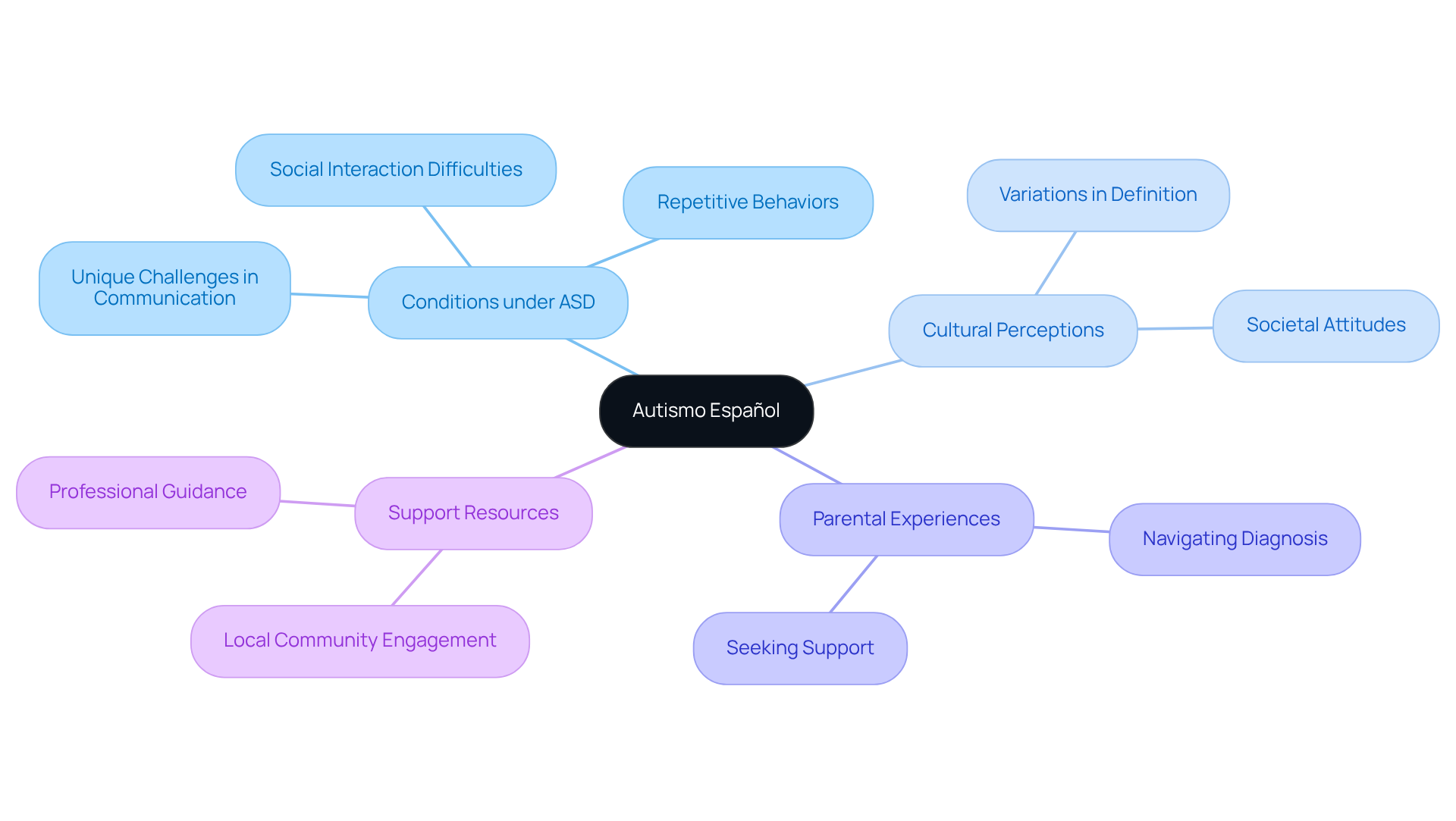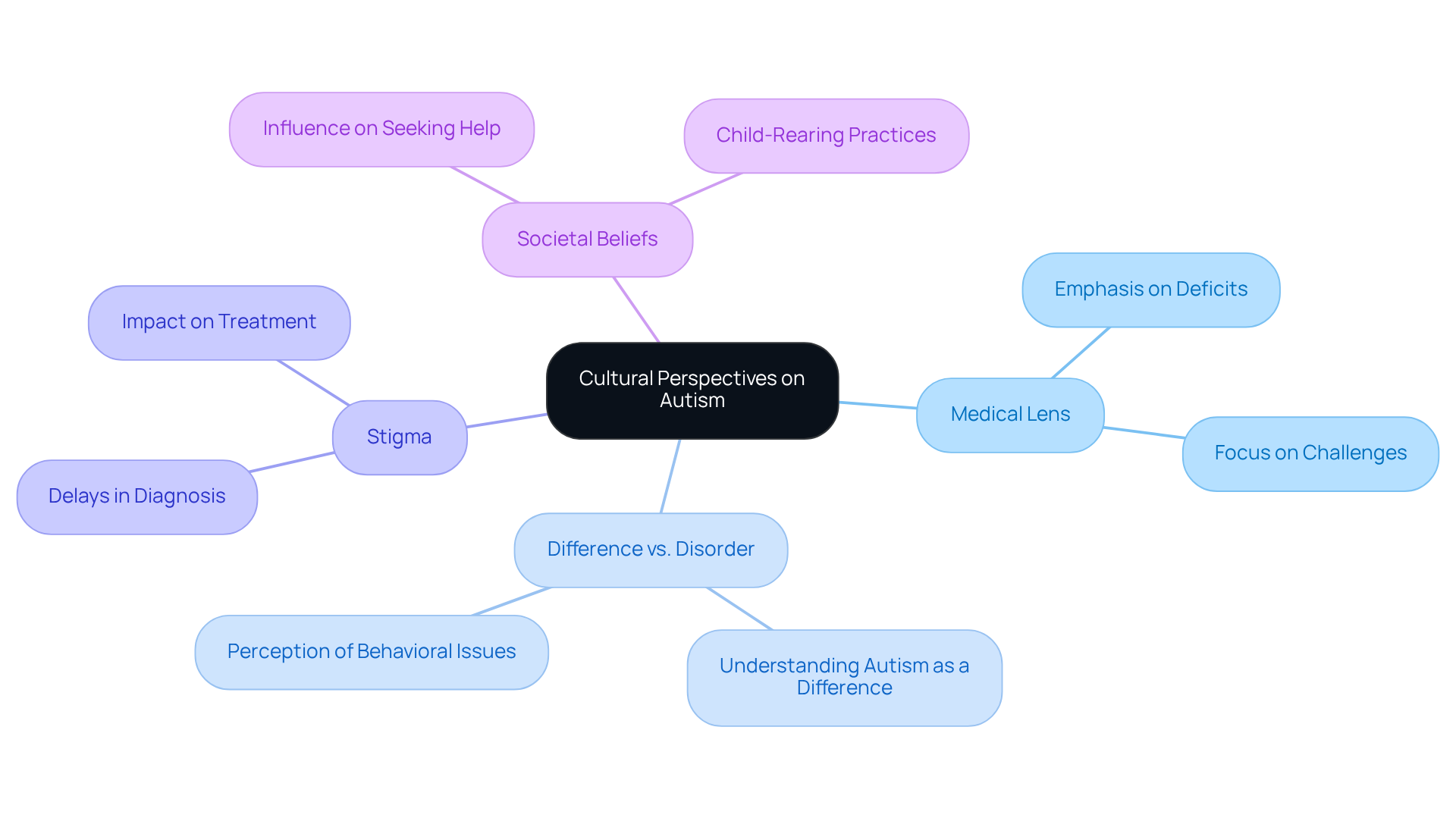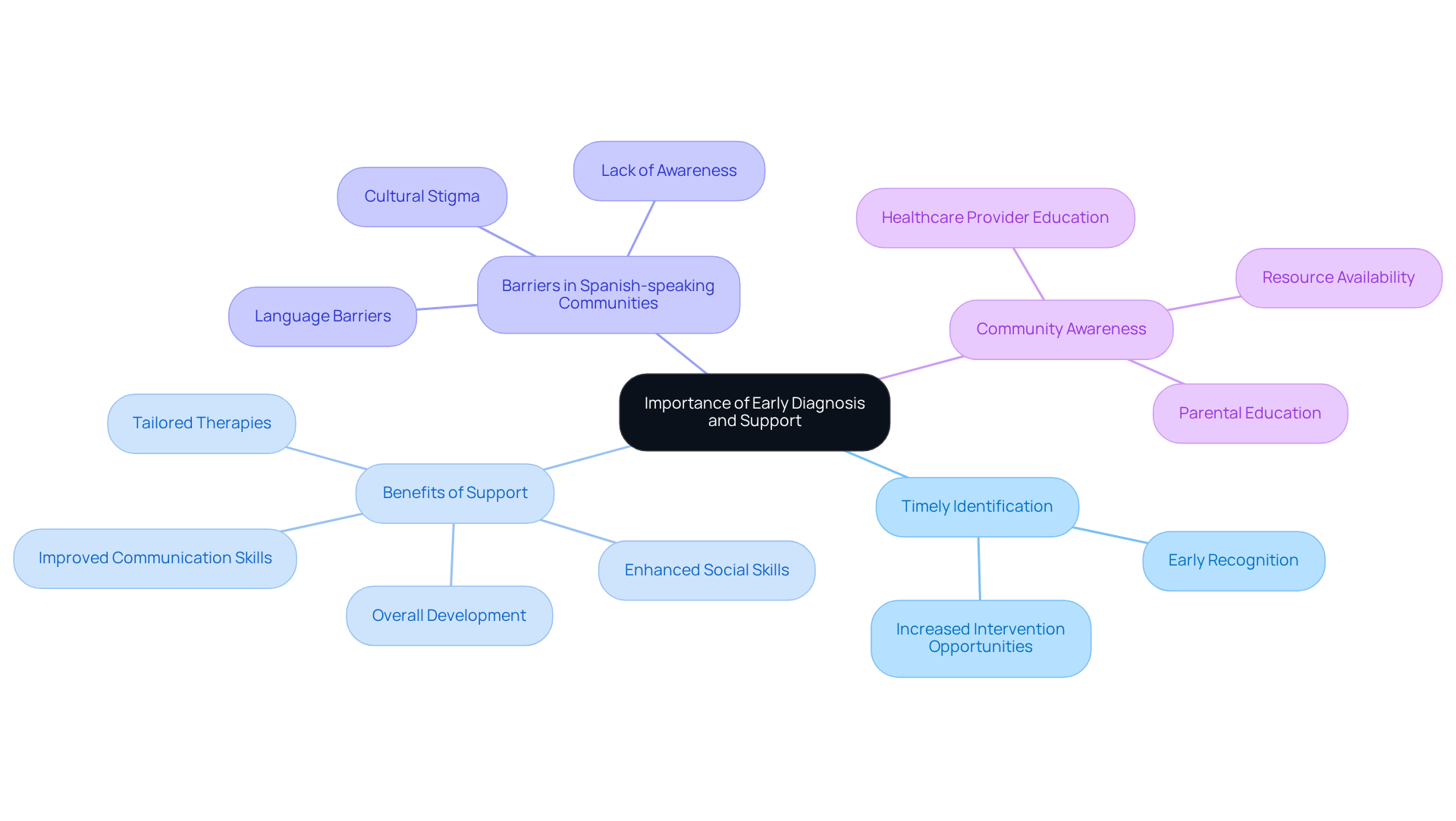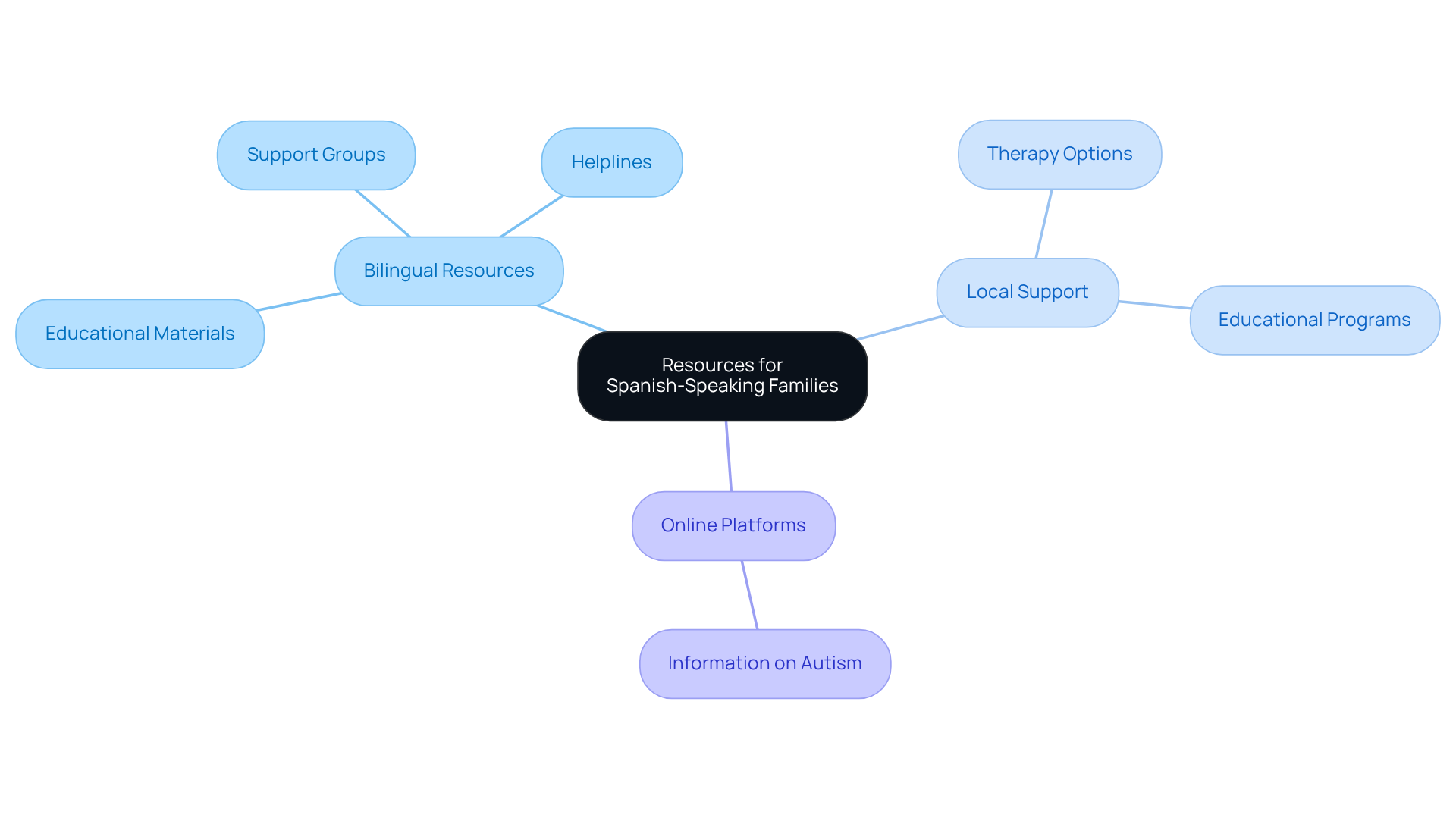Overview
This article delves into the definitions and cultural insights surrounding autism in Spanish-speaking contexts. It emphasizes that 'autismo' encompasses various neurodevelopmental disorders, often marked by challenges in social interaction and communication. Understanding these cultural perceptions is crucial, as they shape the experiences of families. Early diagnosis and support are vital, significantly influencing treatment approaches and the overall well-being of those navigating autism.
As parents, you may find yourselves seeking clarity and understanding in this complex landscape. The journey can be daunting, but knowing that you are not alone can provide comfort. Many families share similar challenges, and connecting with resources can make a world of difference. Together, we can foster a supportive community that prioritizes the needs of our children and families.
Let’s explore these insights further and consider how we can advocate for early intervention and compassionate support. By sharing our stories and experiences, we can create a richer understanding of autism that resonates deeply within our communities. Your voice matters, and together, we can pave the way for a brighter future for those affected by autism.
Introduction
Understanding autism within the Spanish context reveals a complex interplay of definitions, cultural beliefs, and societal attitudes that shape the experiences of families navigating this neurodevelopmental disorder. The term 'autismo' encompasses a range of conditions under the Autism Spectrum Disorder umbrella, and the nuances of diagnosis and treatment can vary significantly across Spanish-speaking communities.
How do cultural perceptions influence the recognition and support of autism?
What barriers must we overcome to ensure that every child receives the care they need?
These questions are vital as we seek to foster understanding and compassion in our communities.
Define Autism in the Spanish Context
In the context of autismo español, the term 'autismo' encompasses a variety of neurodevelopmental disorders, each marked by unique challenges in social interaction, communication, and repetitive behaviors. This term includes various conditions under the umbrella of Autism Spectrum Disorder (ASD), known in Spanish as 'trastorno del espectro autista' (TEA). Understanding this condition requires us to consider the cultural perceptions and societal attitudes that shape the diagnosis and treatment of autismo español in Spanish-speaking countries.
For many parents, navigating these waters can be daunting. The definition of autism may vary slightly across regions, reflecting the diverse experiences of families. However, the core characteristics remain consistent with international standards, underscoring the importance of culturally sensitive approaches to diagnosis and intervention. It’s crucial for families to feel supported and understood, as they seek the best pathways for their children.
If you find yourself in this situation, remember that you are not alone. There are resources available that can provide guidance and support tailored to your specific needs. Engaging with local communities and professionals who understand these nuances can make a significant difference in your journey.

Explore Cultural Perspectives on Autism
Cultural viewpoints on autism within Spanish-speaking communities can vary widely. Some may view this condition through a medical lens, emphasizing deficits and challenges, while others may see it as a difference rather than a disorder. For instance, in many Latino communities, a stigma may be associated with autism, leading to delays in diagnosis and treatment. Families might interpret symptoms as behavioral issues instead of recognizing them as signs of autism. This misunderstanding can create a barrier to seeking help.
Moreover, societal beliefs about child-rearing and mental health can significantly influence how families pursue assistance and support. Understanding these cultural nuances is crucial for professionals working with Spanish-speaking families. By acknowledging these perspectives, practitioners can foster more effective communication and develop tailored interventions that respect and honor cultural values. This approach not only enhances understanding but also builds trust and rapport, essential elements in supporting families on their journey.

Highlight the Importance of Early Diagnosis and Support
Recognizing the condition in a timely manner is vital for effective intervention and support. Research shows that when children are identified early, they are more likely to benefit from tailored therapies that improve their communication, social skills, and overall development. Yet, in Spanish-speaking communities, challenges such as language barriers, cultural stigma, and a lack of awareness can hinder timely diagnosis of autismo español. It is essential for healthcare providers to raise awareness about the signs of the condition and the importance of seeking help without delay.
Support systems, including parental education and community resources, are crucial in ensuring families receive the guidance they need to navigate the complexities of developmental disorders. By fostering an environment that encourages early identification and support, we can significantly improve the lives of children with developmental disorders and their caregivers. Together, let’s work towards breaking down these barriers and creating a community where every child can thrive.

Identify Resources and Support for Spanish-Speaking Families
For households that speak Spanish and are facing developmental disorders such as autismo español, a wealth of resources is available to provide much-needed support and information. Organizations like Autism Speaks, along with local advocacy groups, offer bilingual resources that include:
- Educational materials
- Support groups
- Helplines
These resources are designed to empower families, ensuring they feel understood and supported in their journey.
Many communities have also established networks that connect households with nearby services, such as:
- Therapy options
- Educational programs tailored for children with developmental disorders
This local support can make a significant difference, helping families navigate their unique challenges.
Additionally, online platforms provide valuable information about autismo español, assisting parents in understanding the complexities of autism diagnosis and treatment. These resources can be instrumental in helping families gain the knowledge they need to advocate effectively for their children.
By utilizing these available resources, families can equip themselves with the tools necessary to ensure their children receive the appropriate care and interventions. Remember, you are not alone in this journey—there is a supportive community ready to help you every step of the way.

Conclusion
Understanding autismo español invites us to appreciate the unique cultural and societal contexts that shape perceptions and experiences of autism in Spanish-speaking communities. The complexities surrounding the definition and diagnosis of autism highlight the necessity for culturally sensitive approaches that cater to the diverse backgrounds of families affected by this condition.
Throughout this article, we emphasize the importance of recognizing autism as a spectrum, encompassing various neurodevelopmental disorders. Cultural perspectives significantly influence how families interpret symptoms and seek support, often shaped by societal beliefs and stigma. Early diagnosis and intervention emerge as critical factors leading to better outcomes for children with autism; yet, barriers such as language and cultural misunderstandings persist.
Ultimately, fostering awareness and access to resources for Spanish-speaking families is essential. By breaking down these barriers, encouraging early intervention, and providing tailored support, we can create an environment where every child has the opportunity to thrive. The journey may be challenging, but with the right resources and community support, families can navigate the complexities of autism and advocate effectively for their children's needs. Let’s come together to ensure that no family feels alone in this journey.
Frequently Asked Questions
What does the term 'autismo' refer to in the Spanish context?
In the Spanish context, 'autismo' refers to a variety of neurodevelopmental disorders characterized by challenges in social interaction, communication, and repetitive behaviors. It includes conditions under the Autism Spectrum Disorder (ASD), known in Spanish as 'trastorno del espectro autista' (TEA).
How does the definition of autism vary across different regions in Spanish-speaking countries?
The definition of autism may vary slightly across regions, reflecting the diverse experiences of families. However, the core characteristics of autism remain consistent with international standards.
Why is it important to consider cultural perceptions in the diagnosis and treatment of autism in Spanish-speaking countries?
Cultural perceptions and societal attitudes significantly shape the diagnosis and treatment of autism, highlighting the need for culturally sensitive approaches to ensure families feel supported and understood.
What challenges do parents face when navigating the autism diagnosis and treatment process?
Parents often find navigating the autism diagnosis and treatment process daunting due to varying definitions and the need for culturally relevant support.
Are there resources available for families dealing with autism in Spanish-speaking countries?
Yes, there are resources available that provide guidance and support tailored to the specific needs of families dealing with autism. Engaging with local communities and professionals can greatly assist in this journey.




